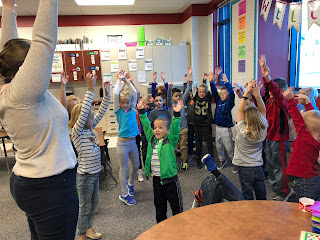Lesson Plan for Eighth Visit
November 27, 2018
Elise Joyner
Alyssa Adair’s 1st Grade Class
Blackridge Elementary School
Adapted from: Process Drama - Unity in
the Classroom
Creator(s): Emily,
Makenna C., Jamie (TMA 352 Students)
Title: Unity in the classroom
Grade Level: 1st
grade
Time to Teach: 30 minutes
Big Idea(s): Unity in the
classroom
●
Sharing what’s important to us
●
Creating unity amongst differences
●
Combining strengths
●
Adapting/flexibility
Drama/Theatre Standard(s): Standard 1.T.CO.2: Identify
connections to other content areas in dramatic play or guided drama
experiences.
Other
Core: 2. Develop social skills and ethical responsibility. a. Respect
similarities and differences in others. b. Treat others with kindness and
fairness. c. Follow classroom and school rules. e. Include others in learning
and play activities. f. Participate with others when making decisions and
solving problems. g. Function positively as a member of a family, class,
school, and community.
Objective(s):
Students will be
able to define unity and demonstrate how to promote unity in the classroom and
school community.
Indicators:
Students will identify situations that
threaten classroom unity. They will use creative solutions to combat those
threats and demonstrate what those solutions look like.
Lesson Body
Warm Up: “Seagulls and
Crabs” tag (triangle tag)
●
Students A and B hold hands, facing each other, with
their arms in front of them. Students C and D stand on either side if their
hands. Student C (the seagull) tries to tag student D (the crab). Students A
and B try to prevent the seagull from tagging the crab by blocking their path
to them.
●
After a couple minutes, switch so everyone has a
chance to be a crab or seagull.
Hook: Video: Unity for
Kids
●
Before video:
○
Trust activity - have students pair off and tell
each other what their own biggest strengths are
○
Guide students to look for how the small animals in
the video use their strengths.
●
After video:
○
How did the animals use their strengths against
larger animals?
○
What would happen if there had been just one small
animal?
○
Was this the first time they did this or were they
prepared?
○
How did the small animals know if one of the other
animals needed help?
■
On signal they unified against the predator
Instruction: Applying the video
to our class
●
Define “unity” together as a class
○
(joining together as a whole for a common goal)
●
What are some “predators” against unity or things
that could be bad in our classroom?
○
“I’ve noticed…”
○
How can we prevent or address those “predators” or
bad things?
Practice: Improvisation: Role
play based on students’ answers about what prevents unity in our classroom
●
What can we do when something like this happens?
What would that look like?
●
Students will demonstrate what they can do to
encourage unity through improvised role plays that they perform for the rest of
the class
○
When possible, have the student who suggested the
solution be part of the group to role play. Also be aware that students get
equal opportunities to participate in role plays.
○
Try to have a couple groups planning at a time while
you continue the discussion with the rest of the students. Don't leave them
with nothing to do.
●
Discussion: What was the problem? How did they
address the problem?
●
What can we do to remind ourselves and/or others
that we need to be united?
○
Allow students to discuss possibilities for a unity
signal, similar to those used by the small animals in the video
Assessment: Journaling
●
Students will write in their journals about the
process drama lesson-This can be anything they choose (a song, poem, story,
image, …)
○
What did you learn today?
○
What will YOU do to promote unity?


Comments
Post a Comment